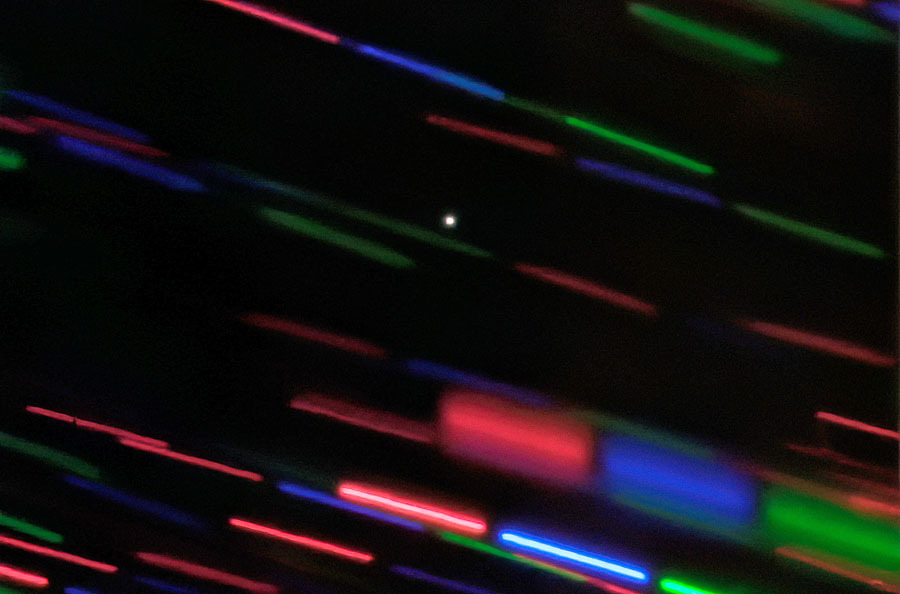26.09.2024

Starting September 29th, another moon of sorts will briefly accompany Earth. The house-size asteroid will stick around less than 2 months.
We’re about to have company! Starting on September 29th, our planet will be accompanied by another moon of sorts. But this house-size asteroid is only a temporary companion — and sadly out of reach of backyard telescopes.
A telescope array in South Africa, known as the Asteroid Terrestrial-impact Last Alert System, discovered this temporary mini-moon — called 2024 PT5 — on August 7th. At magnitude 27.6, scientists estimate it is roughly 10 meters across, about the size of a two-story house. The boulder will circle Earth for almost two months, departing from its mini-moon status on November 25th.
Only about four other such temporary mini-moons of Earth have ever been found before, and no others are currently in such orbits. Richard Binzel (MIT), who has long specialized in determining asteroids’ properties, describes mini-moons this way: “It’s as if you are taking a long walk in the woods and a dog comes along and joins you for a while, before wandering away. During that time, you had a companion, but it is not your dog.”
(Earth also has at least two “quasi-moons”, but although those appear to circle our planet, they are much more distant and not within its gravitational influence.)
After the object’s discovery, brothers Carlos and Raul de la Fuente Marcos (both at Universidad Complutense de Madrid) determined that this particular asteroid, while not “our dog,” is going to be our companion for almost two months. Writing in Research Notes of the AAS, they find that after the asteroid leaves its minimoon orbit in November, it will return to a horseshoe-type orbit, in which it sometimes approaches Earth but then backs away again.
Extensive numerical simulations show that this period of Earth-circling is essentially a certainty, Carlos tells Sky & Telescope. Unfortunately though, he says, it is too faint to be seen by even most large amateur telescopes — it would take a primary mirror of at least 30 inches and a CCD or CMOS imager to capture it.
“Theoretical estimates suggest that short engagements happen every few years, and long episodes may take place every one or two decades,” he says. Only one mini-moon found so far, 2020 CD3, remained around Earth for as long as a few years. “The truth is that we have very limited knowledge of this population of objects that could be our nearest cosmic neighbors,” he says.
This particular object, 2024 PT5, will return to Earth’s vicinity and again be a temporary mini-moon in 2055, though for an even shorter spell. Then, after drifting away again, it might come back in 2084, he says. “This third one is less certain,” he says, but “mini-moon engagements are usually recurrent.”
The origins of this object are unknown, but Alan W. Harris (Space Science Institute) says given its relative velocity to Earth, “it is much more probably lunar ejecta (or space junk).” In fact, it’s more likely to originate from the Moon than 469219 Kamo'oalewa, a quasi-moon that astronomers suggested earlier this year traces its birth to a lunar farside crater; Harris says it’s moving too fast for this scenario to be likely.
“[2024 PT5] isn’t really gravitationally bound to Earth, so in that sense it is not really a ‘moon.” Harris says. “It will wander off after a single loop . . . It’s just passing by.”
Binzel, who was not involved in this finding, is excited about the discovery. “[Mini-moons] might literally be used as steppingstones to Mars,” he says. “A mini-moon mission offers a shakedown cruise opportunity before committing a human crew and a new class of spacecraft for a much longer-duration and much more distant mission to Mars.”

The International Gemini Observatory / NSF’s National Optical-Infrared Astronomy Research Laboratory / AURA / G. Fedorets
Specifically, he adds, “2024 PT5 is one of the most accessible near-Earth objects yet discovered” in terms of the acceleration needed to reach it and the overall mission duration. Of course it won’t be around for long enough to plan a mission to it, but the discovery of like objects is accelerating. The first such object, 1991 VG, was found in 1991 by James Scotti (Spacewatch), and the second, 2006 RH120, was found in 2006. Then two (including 2020 CD3, shown above) were found in 2020.
“More frequent discoveries of minimoons is a tribute to the increasing capabilities of our survey efforts,” Binzel says. “There are many more to come. We just have to keep looking.”
Quelle: Sky&Telescope
